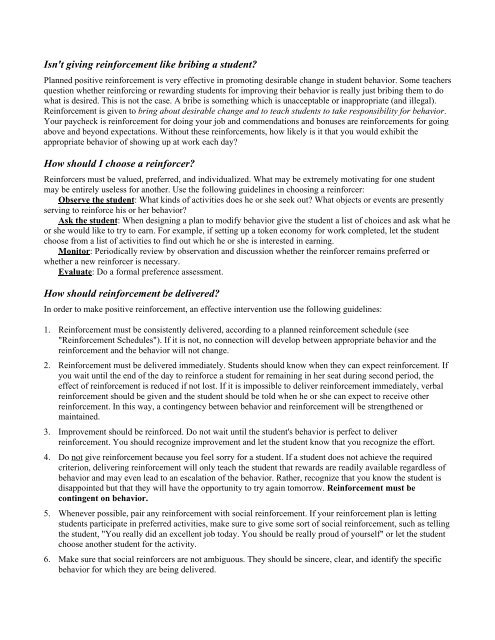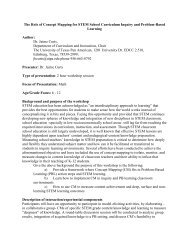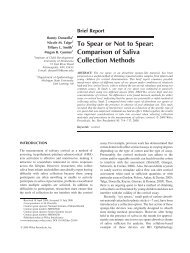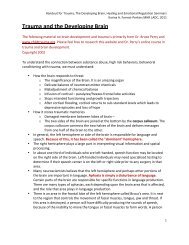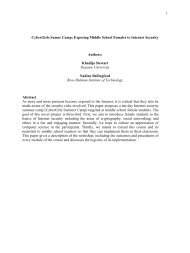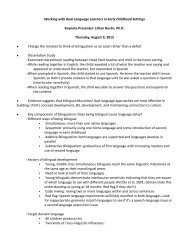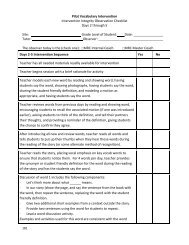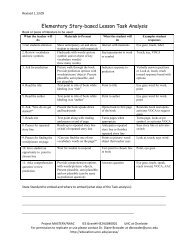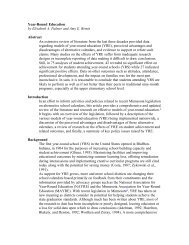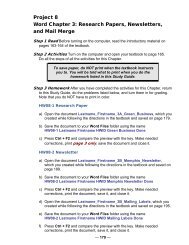Introduction to Positive Ways of Intervening with Challenging Behavior
Introduction to Positive Ways of Intervening with Challenging Behavior
Introduction to Positive Ways of Intervening with Challenging Behavior
Create successful ePaper yourself
Turn your PDF publications into a flip-book with our unique Google optimized e-Paper software.
Isn't giving reinforcement like bribing a student?<br />
Planned positive reinforcement is very effective in promoting desirable change in student behavior. Some teachers<br />
question whether reinforcing or rewarding students for improving their behavior is really just bribing them <strong>to</strong> do<br />
what is desired. This is not the case. A bribe is something which is unacceptable or inappropriate (and illegal).<br />
Reinforcement is given <strong>to</strong> bring about desirable change and <strong>to</strong> teach students <strong>to</strong> take responsibility for behavior.<br />
Your paycheck is reinforcement for doing your job and commendations and bonuses are reinforcements for going<br />
above and beyond expectations. Without these reinforcements, how likely is it that you would exhibit the<br />
appropriate behavior <strong>of</strong> showing up at work each day?<br />
How should I choose a reinforcer?<br />
Reinforcers must be valued, preferred, and individualized. What may be extremely motivating for one student<br />
may be entirely useless for another. Use the following guidelines in choosing a reinforcer:<br />
Observe the student: What kinds <strong>of</strong> activities does he or she seek out? What objects or events are presently<br />
serving <strong>to</strong> reinforce his or her behavior?<br />
Ask the student: When designing a plan <strong>to</strong> modify behavior give the student a list <strong>of</strong> choices and ask what he<br />
or she would like <strong>to</strong> try <strong>to</strong> earn. For example, if setting up a <strong>to</strong>ken economy for work completed, let the student<br />
choose from a list <strong>of</strong> activities <strong>to</strong> find out which he or she is interested in earning.<br />
Moni<strong>to</strong>r: Periodically review by observation and discussion whether the reinforcer remains preferred or<br />
whether a new reinforcer is necessary.<br />
Evaluate: Do a formal preference assessment.<br />
How should reinforcement be delivered?<br />
In order <strong>to</strong> make positive reinforcement, an effective intervention use the following guidelines:<br />
1. Reinforcement must be consistently delivered, according <strong>to</strong> a planned reinforcement schedule (see<br />
"Reinforcement Schedules"). If it is not, no connection will develop between appropriate behavior and the<br />
reinforcement and the behavior will not change.<br />
2. Reinforcement must be delivered immediately. Students should know when they can expect reinforcement. If<br />
you wait until the end <strong>of</strong> the day <strong>to</strong> reinforce a student for remaining in her seat during second period, the<br />
effect <strong>of</strong> reinforcement is reduced if not lost. If it is impossible <strong>to</strong> deliver reinforcement immediately, verbal<br />
reinforcement should be given and the student should be <strong>to</strong>ld when he or she can expect <strong>to</strong> receive other<br />
reinforcement. In this way, a contingency between behavior and reinforcement will be strengthened or<br />
maintained.<br />
3. Improvement should be reinforced. Do not wait until the student's behavior is perfect <strong>to</strong> deliver<br />
reinforcement. You should recognize improvement and let the student know that you recognize the effort.<br />
4. Do not give reinforcement because you feel sorry for a student. If a student does not achieve the required<br />
criterion, delivering reinforcement will only teach the student that rewards are readily available regardless <strong>of</strong><br />
behavior and may even lead <strong>to</strong> an escalation <strong>of</strong> the behavior. Rather, recognize that you know the student is<br />
disappointed but that they will have the opportunity <strong>to</strong> try again <strong>to</strong>morrow. Reinforcement must be<br />
contingent on behavior.<br />
5. Whenever possible, pair any reinforcement <strong>with</strong> social reinforcement. If your reinforcement plan is letting<br />
students participate in preferred activities, make sure <strong>to</strong> give some sort <strong>of</strong> social reinforcement, such as telling<br />
the student, "You really did an excellent job <strong>to</strong>day. You should be really proud <strong>of</strong> yourself" or let the student<br />
choose another student for the activity.<br />
6. Make sure that social reinforcers are not ambiguous. They should be sincere, clear, and identify the specific<br />
behavior for which they are being delivered.


